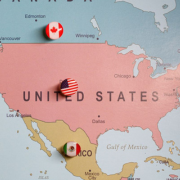Navigating the Impact of Tariffs on US Middle-Market Businesses: Strategies for Resilience and Growth

In recent years, the shifting landscape of global trade policies has introduced significant challenges for businesses across the United States, from supply chain shortages in microchips to emissions regulations. Among the most impactful changes have been the implementation of tariffs on critical goods like steel, aluminum and other raw materials. For middle-market businesses, the ripple effects of these tariffs can have far-reaching consequences on profitability, operations and competitive positioning. However, there are proactive steps that companies can take to mitigate these challenges and navigate the evolving trade environment with confidence.
Increased Costs and Squeezed Margins
A tariff is a tax on imported goods, typically aimed at protecting local jobs and industries from foreign competition. For example, imagine the US government imposes a 15% tariff on imported electronics from South Korea. If a South Korean smartphone typically costs $800, the tariff would increase the price to $920. This higher cost might encourage consumers to consider purchasing smartphones manufactured in the US or from countries with lower or no tariffs, thereby protecting local electronics manufacturers from foreign competition.
One of the most immediate impacts of tariffs is the rise in costs for essential materials. Tariffs on products such as steel and aluminum, as well as a range of other goods, can significantly increase the price of raw materials and finished products. For many middle-market companies, this can lead to squeezed profit margins, especially if they rely heavily on imported components. The added expense makes it difficult to maintain competitive pricing without sacrificing profitability.
In this context, customs goods valuation methods become a critical tool for managing costs. Companies can explore various valuation strategies to ensure that they are not overpaying in tariff assessments. By carefully selecting the most advantageous valuation method, businesses can minimize the tariff burden and protect their bottom line.
Supply Chain Disruptions
During his first term, President Donald Trump introduced tariffs on nearly $380 billion worth of goods, breaking with decades of free trade policy. Now, in his second term, he has angled for the imposition of even more expansive tariffs, including a 20% duty on Chinese imports and 25% tariffs on products from Canada and Mexico. These moves represent a seismic shift in US trade policy, targeting our three biggest trade partners.
Tariffs can also disrupt existing supply chains, forcing companies to find alternative suppliers or alter their sourcing strategies as we’ve seen in recent years. For middle-market businesses, this disruption can lead to delays in production and delivery, which could increase operational costs. Shifting to new suppliers may involve additional logistics challenges, longer lead times and potentially higher prices for raw materials.
To respond effectively to supply chain disruptions, companies should reassess their supplier networks and consider inventory hoarding as a potential strategy. If a business can purchase more inventory and store it within the US before tariffs rise further, they may reduce exposure to future price increases. However, this strategy requires careful financial analysis, particularly if the inventory is being debt funded. The company must assess whether the interest rate on debt funding is lower than the tariff rate to ensure this approach remains financially advantageous.
Competitive Disadvantages
For businesses that rely on importing materials from countries subject to tariffs, the cost burden can make them less competitive compared to firms that source locally or from countries with favorable tariff conditions. Middle-market companies may find themselves facing a competitive disadvantage, particularly when rivals are able to leverage lower tariffs or cheaper materials to offer more attractive prices to customers.
In this scenario, it’s critical for businesses to explore alternatives such as country of origin analysis. By thoroughly evaluating the goods’ country of origin, companies may discover opportunities to shift the origin designation to a country that is either tariff-free or subject to lower tariff rates. This strategy could involve minor modifications to products or the sourcing of materials from a different location, ultimately improving the cost structure and positioning of the business in the marketplace.
Market Volatility and Uncertainty
The uncertainty surrounding trade policies creates significant market volatility, which can be particularly challenging for middle-market companies. The unpredictability of tariffs, along with frequent changes in trade agreements, can make it difficult for businesses to plan effectively for the future. Fluctuations in material costs, currency exchange rates and international trade rules add layers of complexity to financial forecasting and long-term strategy.
In this climate of uncertainty, businesses must adopt robust financial planning and risk management strategies. Engaging in advocacy efforts—whether through industry associations or direct dialogue with policymakers—can also help businesses stay informed and potentially influence the regulatory environment to their advantage. Additionally, establishing a flexible and responsive supply chain can allow businesses to pivot quickly in response to changes in tariffs or trade policies.
Strategic Responses for Middle-Market Companies
To effectively navigate the complexities of the current trade landscape, middle-market companies must take a proactive approach to managing tariff-related challenges. Some key strategies include:
Reassessing Supply Chains
Companies should evaluate their supply chains to ensure they are sourcing materials from the most cost-effective and efficient suppliers. This may involve diversifying supply chains, finding local suppliers or exploring new international markets with favorable tariff agreements.
Cost Management
Effective cost control measures are essential in times of rising prices. Companies can explore options like inventory hoarding to stockpile goods before tariffs increase or work with suppliers to lock in prices for the future.
Licensing IP to Local Manufacturers
In some cases, businesses may be able to reduce their tariff exposure by licensing intellectual property (IP) to local manufacturers in foreign markets. By allowing local companies to produce goods for distribution, businesses can bypass tariffs on finished products, while still maintaining control over their IP and benefiting from local market access.
Robust Financial Planning
Regular financial reviews and scenario planning are essential. A business should assess its cash flow and working capital needs in the face of tariffs.
Advocacy and Industry Collaboration
Participating in industry groups and advocating for favorable trade policies can help middle-market companies stay informed and potentially influence tariff decisions. Collaboration with other businesses can also help share insights and develop best practices for managing tariff-related challenges.
Turning Tariff Challenges into Opportunities
As the global trade environment continues to evolve, middle-market businesses face increasing pressure from tariffs and trade policies. While these challenges can impact profitability, supply chains and competitive positioning, the right strategies can ensure companies navigate tariff impacts with resilience and agility. With careful planning and an adaptable approach, middle-market businesses can turn these challenges into opportunities for growth and long-term success.
Ready to safeguard your business against the impact of tariffs? Frazier & Deeter can help you build tailored strategies that drive resilience, efficiency and profitability. Contact us today to learn how our expertise can help your business adapt and thrive in an unpredictable trade landscape.
Contributors
Dave Kim, Partner & National Practice Leader, International Tax
Explore related insights
-
How to Choose the Right Cybersecurity Framework: A Guide for Mid-Market Companies
Read more: How to Choose the Right Cybersecurity Framework: A Guide for Mid-Market Companies
-
Are Tariffs Subject to Sales Tax? It Depends on the Details.
Read more: Are Tariffs Subject to Sales Tax? It Depends on the Details.






